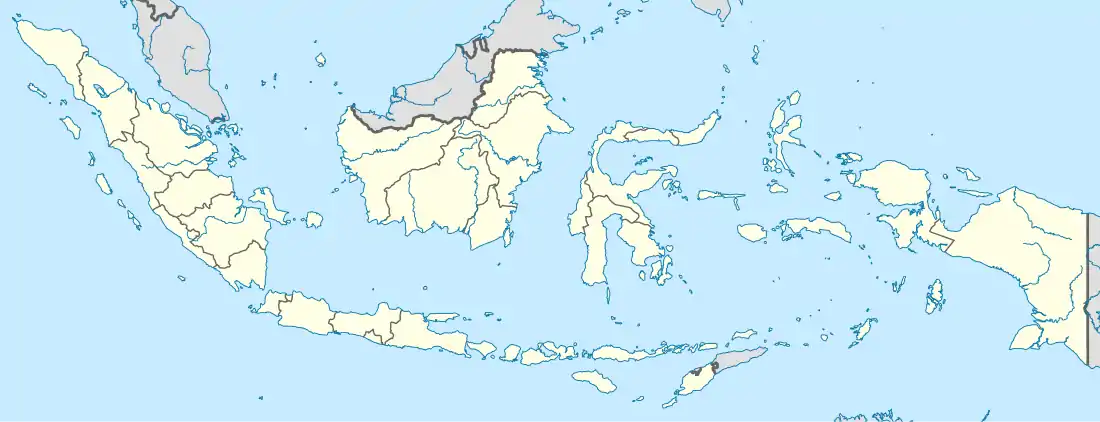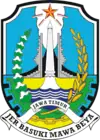Kediri (city)
Kediri (Javanese: ꦏꦸꦛꦑꦼꦝꦶꦫꦶ) is an Indonesian city, located near the Brantas River in the province of East Java on the island of Java. It covers an area of 63.40 km2 and had a population of 268,950 at the 2010 Census;[2] the latest official estimate (as at mid 2019) is 294,950. [3] It is one of two 'Daerah Tingkat II' that have the name 'Kediri' (the other is the Regency of Kediri, which surrounds the city). The city is administratively separated from the Regency, of which it was formerly the capital.
City of Kediri | |
|---|---|
| Other transcription(s) | |
| • Javanese | ꦏꦸꦛꦑꦼꦝꦶꦫꦶ |
| • Pegon | كاڎيري |
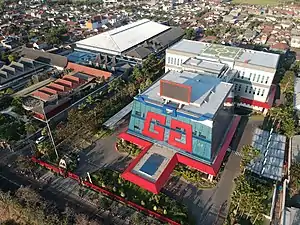 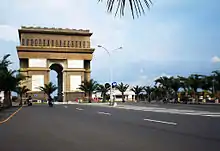  | |
 Coat of arms | |
| Motto(s): Joyo ing Boyo (Javanese: Triumphant Against Catastrophe) | |
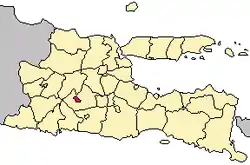 Location within East Java | |
| Coordinates: 7°48′59.8″S 112°0′42.9″E | |
| Country | Indonesia |
| Province | East Java |
| Government | |
| • Mayor | Abdullah Abu Bakar |
| • Vice Mayor | Vacant |
| Area | |
| • Total | 63.4 km2 (24.5 sq mi) |
| Elevation | 3 m (10 ft) |
| Population (mid 2019) | |
| • Total | 293,950 |
| • Density | 4,600/km2 (12,000/sq mi) |
| [1] | |
| Time zone | UTC+7 (IWST) |
| Area code | (+62) 354 |
| Vehicle registration | AG |
| Website | kedirikota.go.id |
Archaeological artefacts discovered in 2007 appeared to indicate that the region around Kediri may have been the location of the Kediri Kingdom, a Hindu kingdom in the 11th century.[4]
The city is a major trade centre for the Indonesian sugar and cigarette industry.[5] Kediri is the second largest city by economy in East Java, after Surabaya, with a 2016 estimated GDP at Rp76.95 trillion.[6]
History
Traditionally, the city of Kediri is said to have been founded on 27 July 879,[7] and today the city's anniversary is celebrated on that date.[8] The Brantas River valley was known as the site of classical Javanese culture, particularly between the 10th and 15th centuries. The town of Kediri was established by King Airlangga on the banks of the upper Brantas river in 1042. It was originally called Dahanapura or Daha. After the death of Airlangga his kingdom was divided into two parts: the kingdom of Panjalu in the west, and the kingdom of Janggala in the east. Daha became the capital of Panjalu, and later the capital of the Kediri kingdom.[9]:146–147,158 Over the centuries, control of the city passed to the Singhasari, Majapahit, Demak and Mataram kingdoms.
The name "Kediri", or "Kadiri", is derived from the Sanskrit word Khadri, meaning Indian Mulberry, indicative of the mulberry trees (locally known as pacé or mengkudu) which grew in the area.
.png.webp)
After the era of the Javanese kingdoms, Kediri went into decline, becoming a small rural settlement, which was later annexed by the Dutch East India Company (VOC) as part of the Dutch conquest of Java. East Java in the 1740s was controlled by Cakraningrat IV, a Madurese regent who was favorably disposed toward the VOC, as he believed the Dutch would help him in securing the independence of Madura from the Kasunanan Kartasura kingdom. However, when his plans were rejected by the VOC, Cakraningrat rise against the Europeans. The rebellion was ultimately suppressed by the VOC, assisted by two generals sent by Pakubuwana II, Sunan Kartasura. Kediri then became part of the VOC and remained under Dutch control until the independence of Indonesia in 1945.[10]
Kediri began to flourish when the Dutch East Indies founded the autonomous Gemeente Kediri in 1906. Zelfstanding Gemeenteschap (self-government with full autonomy) was granted in 1928.
During the Indonesian National Revolution in 1945–1949, Kediri became a target of General Sudirman's guerrilla campaign. In 1965, after the failed 30 September Movement coup, Kediri suffered terrible bloodshed in which thousands of people were killed.
The Gudang Garam kretek tobacco industry was established in 1958 by Chinese Indonesian Tjoa Ing Hwie. He purchased vast lands in Kediri and established a kretek cigar factory. Today, Gudang Garam is the major employer of the city, with more than 40,000 workers.
Administrative divisions
The city of Kediri is divided into three districts (kecamatan), tabulated below with their areas and population totals from the 2010 Census[11] and the official estimates for mid 2019.[12] The table also includes the number of administrative villages (urban kelurahan) in each district, and its postal codes.
| Name | Area in km2 | Population Census 2010[13] | Population Estimate mid 2019[14] | Number of villages | Post codes |
|---|---|---|---|---|---|
| Mojoroto | 24.60 | 108,369 | 112,545 | 14 | 64111-64119 |
| Kota Kediri | 14.90 | 81,803 | 91,276 | 17 | 64121-64129 |
| Pesantren | 23.90 | 78,335 | 91,129 | 15 | 64131-64139 |
| Totals | 63.40 | 268,507 | 294,950 | 46 |
Society and culture
Being the site of an ancient capital of Javanese kingdoms, the city is one of the major cultural center for Javanese people, the city also contains some ancient ruins and candis that dates back to the era of Kediri and Majapahit kingdom.
Sport
Kediri is home of Persik Kediri which plays in Premier Division of Indonesian Football League. Persik Kediri has won total two title of Premier Division of Indonesian Football League, last occurring in 2006.
Education
Kediri city has Three National Universities, they are Universitas Brawijaya (branch III Kediri),[15] STAIN Kediri, Politeknik Negeri Kediri. Kediri also has many private institutions for higher-education, such as Institut Ilmu Kesehatan Bhakti Wiyata, Universitas Nusantara PGRI Kediri, Universitas Kadiri, and Universitas Islam Kadiri.
Tourism
The city of Kediri hardly has any natural attractions for a tourist destination. A few amusement parks are present, e.g. Paggora Amusement Park, Tirtayasa Water Park, Selomangleng Water Park. Selomangleng Cave is a man-made cave, allegedly used by the princess Dewi Kilisuci to meditate, according to folk tales. A few shopping centres are also built in the city, such as Golden Swalayan, and Kediri Mall. Along with the older shopping district Jalan Dhoho they serve the population of Kediri (both the city and the regency) and the surrounding areas.
List of mayors
Since 1906 Kediri was given status of gemeente, along with its gemeenteraad. The head was an assistent-resident. Since 1929 its status was changed to stadsgemeente with a burgemeester as its head. With the Act no. 16 Year 1950, Kediri is given the status of Kota Besar with a walikota (mayor) within Indonesian administrative structure[16]
Dutch East-Indies period
- Mr. L.K. Wennekendonk (1929–1936)
- J.G. Ruesink (1936–1940)
- M. Scheltema (1940–1941)
- Dr. J.R. Lette (1941–1942)
Indonesian period
- R. Soeprapto (1945–1950)
- R. Dwidjo Soemarto (1950–1960)
- R. Soedjono (1960–1966)
- Hartojo (1966–1968)
- Anwar Zainuddin (1968–1973)
- Drs. Soedarmanto (1973–1978)
- Drs. Setijono (1978–1989)
- Drs. Wijoto (1989–1999)
- H.A. Maschut (1999–2009)
- Dr. H. Samsul Ashar Sp.PD (2009–2014)
- Abdullah Abu Bakar, S.E. (2014-now)
Climate
Kediri has a tropical savanna climate (Aw) with moderate to little rainfall from June to October and heavy rainfall from November to May.
| Climate data for Kediri | |||||||||||||
|---|---|---|---|---|---|---|---|---|---|---|---|---|---|
| Month | Jan | Feb | Mar | Apr | May | Jun | Jul | Aug | Sep | Oct | Nov | Dec | Year |
| Average high °C (°F) | 29.5 (85.1) |
29.6 (85.3) |
29.9 (85.8) |
30.5 (86.9) |
30.7 (87.3) |
30.8 (87.4) |
30.7 (87.3) |
31.4 (88.5) |
32.2 (90.0) |
32.3 (90.1) |
31.4 (88.5) |
30.2 (86.4) |
30.8 (87.4) |
| Daily mean °C (°F) | 25.5 (77.9) |
25.6 (78.1) |
25.7 (78.3) |
26.0 (78.8) |
25.9 (78.6) |
25.5 (77.9) |
25.0 (77.0) |
25.4 (77.7) |
26.2 (79.2) |
26.6 (79.9) |
26.4 (79.5) |
25.8 (78.4) |
25.8 (78.4) |
| Average low °C (°F) | 21.5 (70.7) |
21.6 (70.9) |
21.6 (70.9) |
21.6 (70.9) |
21.1 (70.0) |
20.2 (68.4) |
19.4 (66.9) |
19.5 (67.1) |
20.2 (68.4) |
21.0 (69.8) |
21.4 (70.5) |
21.5 (70.7) |
20.9 (69.6) |
| Average rainfall mm (inches) | 324 (12.8) |
314 (12.4) |
316 (12.4) |
206 (8.1) |
134 (5.3) |
41 (1.6) |
39 (1.5) |
23 (0.9) |
27 (1.1) |
52 (2.0) |
136 (5.4) |
274 (10.8) |
1,886 (74.3) |
| Source: Climate-Data.org[17] | |||||||||||||
Notable people from Kediri
- Susilo Wonowidjojo, an Indonesian billionaire businessman and owner of Gudang Garam
- Pramono Anung, Indonesian Secretary of the Cabinet (2015–...)
- Nurbayan, singer and songwriter
- Anthony Fokker, Dutch aviation pioneer and aircraft manufacturer
See also
References
- Badan Pusat Statistik, Jakarta, 2020.
- Biro Pusat Statistik, Jakarta, 2011.
- Badan Pusat Statistik, Jakarta, 2020.
- Kediri archeological discovery offers clues on ancient kingdom Archived 28 March 2007 at the Wayback Machine, The Jakarta Post, 24 March 2007.
- Kediri, Encyclopædia Britannica.
- Badan Pusat Statistik (2017). Produk Domestik Regional Bruto Kabupaten/Kota di Indonesia 2012-2016. Jakarta: Badan Pusat Statistik.
- "Selayang Pandang Kota Kediri". Municipal Government of Kediri.
- "Hari Jadi Ke-1.139, Pemkot Kediri Gelar Upacara Manusuk Sima". Radio Republik Indonesia. 27 July 2018.
- Cœdès, George (1968). The Indianized states of Southeast Asia. University of Hawaii Press. ISBN 9780824803681.
- History of Kediri by City Council
- Biro Pusat Statistik, Jakarta, 2011.
- Badan Pusat Statistik, Jakarta, 2020.
- Biro Pusat Statistik, Jakarta, 2011.
- Badan Pusat Statistik, Jakarta, 2020.
- "Program Studi UB Kampus III Kediri | SELMA UB". selma.ub.ac.id (in Indonesian). Retrieved 26 September 2018.
- "Undang-undang No. 16 Tahun 1950" (PDF). hjdih.surabaya.go.id. Jaringan Dokumentasi dan Informasi Hukum. 14 August 1950. Retrieved 2 February 2017.
- "Climate: Kediri". Climate-Data.org. Retrieved 16 November 2020.

